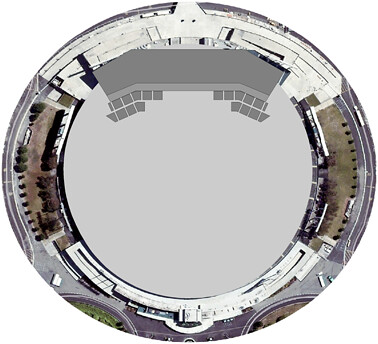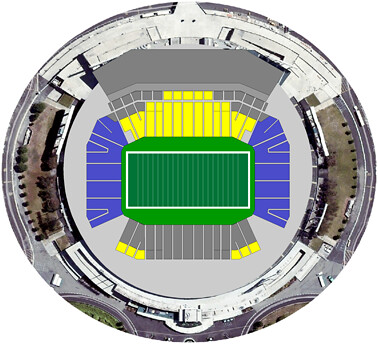- The A's begin construction of Cisco Field by the end of 2010.
- Cisco Field fully signals the Raiders and the Coliseum to fully pursue an extension.
- The NFL either wants an expansion team or a franchise other than the Raiders to move to LA, thereby locking the Raiders out of stadium financing, or they don't want a team there at all thanks to LA market TV ratings and revenues.
- The A's open Cisco Field in April 2012.

Now let's look at how it would look if the original bowl were demolished and the portable seats removed, leaving only the permanent portion of Mt. Davis.

Next, new permanent lower level seats would be built around three-quarters of the field. The old portable Mt. Davis seats would be re-utilized on the other side of the field as temporary seating while the rest of stadium is under construction. New locker rooms and team facilities would be built on the roughly 50,000 square feet under the yellow sections, while back-of-the-house stuff would be placed beneath the blue sections. Since the old press box would be gone, a new one would be built within the third level of suites in Mt. Davis. New temporary capacity would be around 47,000 only for the 2012 season.

The final phase would involve the removal of the portable seats, which could have a future purpose - additional on-demand seating. Notice the large gray area beyond the blue end zone sections? There's plenty of room for concessions, restrooms, and additional seating, up to 5,000 seats.

The red area shows new permanent lower level seating, which would have behind it a level of suites (a la the suites behind the bleachers). In addition, a new West Side Club (teal sections) would be built as a near mirror image to the East Side Club. Above the club seats would be a slightly cantilevered level of luxury suites and third deck. This third deck would be lower than the Mt. Davis third deck because it would have one less level of suites. New ramps would be placed along the wings of the concourse.
One last thing. Beyond the gray circle on the left and right are the current scoreboards. They look pretty far away from the action, don't they? They could be pulled in and lined up immediately behind the end zones seats, which will have a couple of benefits. Not only could the supports and framework be reused, the displays will appear crisper and larger simply because they'll be nearly 100 feet closer to the action. There's space in each frame for a single ultra wide HD screen of 23' x 70', nearly as large as the display at AT&T Park.
Final capacity would be around 63,000, the current NFL sweet spot.
